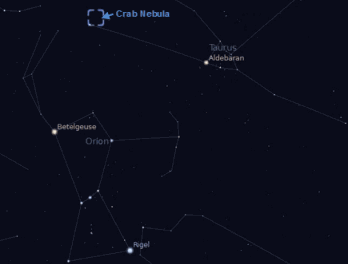It has been said that there are two kinds of astronomy - the astronomy of the Crab Nebula and the astronomy of everything else (Geoffrey Burbidge, 1977). But it was probably sheer chance that this fascinating object appears in pole position in Messier's Catalogue.

Images courtesy of NASA
The Crab Nebula is a supanova remnant: the remains of a giant exploding star. Its explosion was witnessed on earth and is recorded by Chinese Astronomers in 1054AD, although its distance of about 6,500 light-years from us means that the explosion actually took place in the 6th Millenium BC, about the time humans started to learn agriculture.
At the centre of the Crab Nebula is a very disturbed celestial body. The Crab Pulsar is a tiny star, perhaps around 20km in diameter but with a mass greater than our own sun, and around 75,000 times as bright. It rotates at about 30 times a second, and from its North and South poles emits a highly destructive beam of radiomagnetic radiation several light-years ino space.
The Crab Nebula itself is composed 95% of Helium; but the reason for the structure of the nebula as you see it in space is a matter that continues to perplex astronomers.
Here's a good vido about the Crab Nebula by Deep Sky Videos:
And here's M1 gets the pacey Sci-Show Treatment!
Finding the Crab Nebula
You can find the Crab Nebula in the constellation of taurus. It's just about visible with a modest telescope, about two-thirds of the distance between Betelgeuse (the top left star in Orion) and Alnath (the top of the bulls horns in Taurus).

Resources
- Log in to post comments

